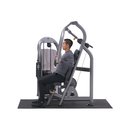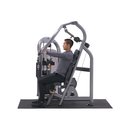If you're someone who is in their later adult years, you may think that it's 'too late' to start getting active and taking care of your health. Many older adults claim that it's too hard for them to start a workout program at this point and they have let themselves get too out of shape.
This is not the case at all, however. More and more older adults are starting to recognize the numerous benefits they will receive from getting on a solid workout program and looking after their nutrition.
It is in these years that you must be even more diligent about what you are doing health-wise because taking actions steps now could significantly impact the quality of life you experience when you are a senior citizen.
Who Are You And What Goals Do You Have?
Regardless of whether you are 40-years old or 60-years old, you're someone who is interested in taking a step forward as far as their overall health is concerned.
You may have the goal of working on increasing your endurance capacity, making it easier to keep up with grandchildren you have or you might want to increase your degree of muscular strength so you aren't struggling to bring in groceries, take out garbage or do anything else that requires lifting something more than five pounds.
On the other hand, your goal for exercise might be simply to increase your overall energy levels and decrease stress. Exercise can function as an amazing stress reliever for those who take a moderate approach to their training and do what makes them feel good. Exercise can also provide a large social aspect for many people who are looking to get out of the house more and meet like-minded individuals.
Whatever specific goals you have, using a workout program that offers both cardiovascular, strength, and flexibility work will be the best approach so that you can develop a well-rounded level of fitness.
Your Source Of Motivation
As an older adult, you might have been instructed by your doctor that it's time to get active in order to keep your body from developing or increasing typical health problems, or any other chronic illness that can develop as you grow older.
Or, perhaps you don't have any current health concerns but you know that if you don't start doing some form of physical activity, over the years it's going to be harder and harder to maintain any type of activity and you could start struggling to complete everyday activities that formerly posed no problem.
You might even have the main source of motivation of trying to recapture how you looked in your younger years - which is perfectly possible with the right type of training.
While you may not be able to look exactly as you did when you were 20, you can certainly tone up your muscles, reduce the appearance of body fat and create a much leaner, slimmer body. In some cases, many older adults actually look better than they did when they were younger, depending on how you looked when you were that age.
Your Nutrition Program
There are going to be some things that the older adult needs to be slightly more aware of when thinking about their nutrition program compared with someone who is of a younger age. Not that older adults will need to eat vastly different than someone younger, just that they do have certain aspects they will want to take care of.
First, if you've been inactive for some time, one thing you may need to alter is your total calorie intake. Since your calorie requirements are largely dependent on your degree of muscle mass, you may have a reduced total amount of muscle mass due to inactivity.
This means you require fewer calories to maintain your body weight, therefore you won't need to eat as much as someone who is younger, has more lean body weight, and is potentially more active in their everyday life.
Now, if you are looking to build lean body mass, you will take in slightly more than the following calorie intake recommendation, while if you are looking to lose body fat, you may want to use an intake that is slightly lower than the following.
Once you start on a diet for a given period of time (2-3 weeks), then you should be able to get a feel for what direction you need to take your calorie intake in order to best accomplish your goals. Getting an understanding on how many calories you are typically taking in is important to having maximal success with your body weight goals.
For a maintenance intake (that is, you are aiming to maintain your body weight while improving your level of fitness), aim for a calorie intake of around 13 calories per pound of body weight. If you are active on a daily basis, you may bring this up to 14, but most people will do best starting slightly lower first.
Many older adults, especially women, tend to neglect taking in enough protein, so that's something else you must consider as well. Aim to get at least one gram per pound of body weight; slightly more than that if you can. This will help prevent you from losing any more muscle mass, which is a huge concern at this point in your life.
In addition to protein, include plenty of fresh fruits and vegetables for your carbohydrate source as they will supply you with the vitamins and minerals necessary for optimal health. Then add small amounts of healthy fat to your diet with each meal, primarily choosing nuts, nut butters, flaxseed and olive oil, or eating fattier types of fish.
Another issue you will really want to watch as an older adult is that you are taking in enough calcium. Again this is something else that many people aren't doing, which could put you at risk for osteoporosis down the road. Including 2-to-3 servings of dairy products each day will help you meet your needs.
Your Supplement Protocol
On the supplement side of things for the older adult, the first thing you should consider is a good quality whey protein powder. This will help ensure you are able to meet your protein needs, which as described above is something most older adults lack and second, supply you with some additional calcium.
Many whey powders will contribute 10% of your daily calcium needs, so this could replace one of the dairy servings in your diet if you aren't a big fan of milk, yogurt, or cheese.
In addition to that, you might consider supplementing with additional calcium and then iron, as that's another nutrient that many older adults miss out on unless they are making a conscious effort to consume a diet rich in red meat.
Once those two have been taken care of, then you want to finally include some fish oil to help meet your essential fatty acid needs, as well as a good multivitamin to make sure you've got all your vitamins and minerals covered as well.
If you're someone who is experiencing some joint issues, you may also want to think about using glucosamine and MSM as well because many adults find this helps them.
Your Workout Program
The approach you should take with your workout program is slightly more relaxed, not pushing yourself incredibly hard, but making sure you are challenging yourselves with two or three workouts a week.
The one workout requirement that does tend to change the most for older adults is the amount of volume and intensity you should be using. You're going to have a slightly reduced overall capacity to recover; therefore, if you start doing too much volume, you're really going to find you burnout quickly and may drop off your workout in a matter of weeks.
You're Going To Have A Slightly Reduced Overall Capacity To Recover.
You're better off to perform less volume, but make sure the sessions you are doing really count. Aim to complete the full body workout program listed below 2-to-3 times a week, while also adding in two or three sessions of cardio training, arriving at a maximum of five different workouts that week.

BodyFit
$6.99/month- 2,500+ expert-created single workouts
- 3,500+ how-to exercise videos
- Detailed workout instruction
- Step-by-step workout tips
- Training at gym or at home
- Access to Workout Plans
- Access to Bodyfit App
- Store Discounts
Already have a Bodybuilding.com account with BodyFit? Sign In

What comes with BodyFit?

- Instructional Videos
Don't risk doing a workout improperly! Avoid injury and keep your form in check with in-depth instructional videos.

- How-to Images
View our enormous library of workout photos and see exactly how each exercise should be done before you give it a shot.

- Step-by-Step Instructions
Quickly read through our step-by-step directions to ensure you're doing each workout correctly the first time, every time.
Cardio Workouts:
While working to build up a base of cardio endurance, aim to complete 20-30 continuous minutes of some type of activity that has you working at a moderate pace.
Most older adults prefer running, using the elliptical, or walking over running as it's less pounding on the body, so if you do decide to choose one of these activities, just make sure you are working at the appropriate intensity. It may help as well to alternate between these activities so you prevent overuse injuries from occurring.
Conclusion
So, don't be scared to get going. If you're an older adult, there are many advantages to taking the time to get active and making changes with your lifestyle. It may feel intimidating at first, but if you approach it slowly and only push yourself a small amount at a time, you should be able to see good results on a continual basis.




